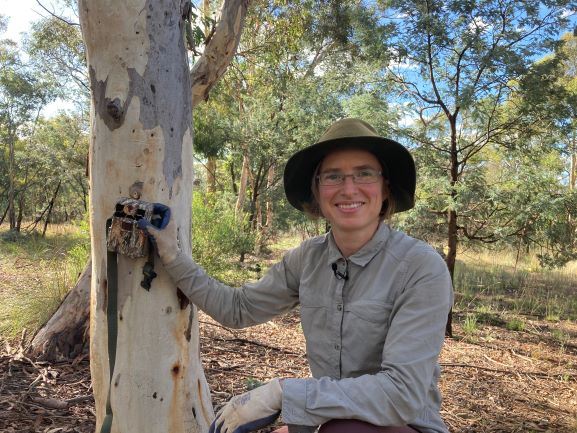Alice McGlashan has spent many years monitoring feral animal predators and wildlife on her property just outside of Canberra. At this webinar/paddock walk she discussed her observations and methods for filming animals to help other small farmers set up monitoring programs for their properties. A useful links section is included at the end of this summary.
You can view the recording of the webinar on the 27 February 2021 HERE.

The key messages from the webinar and paddock walk are summarised below:
1. The key design features to look for in a wildlife camera are;
- Choose a NO glow camera that does not emit any light at night. Cameras that emit a white flash, bright or dim red flash tend to cause feral predators to avoid the camera installation location.
- Choose a camera with a design that you can easily access the SD card and batteries while the camera is strapped to the tree/post.
- Use good quality low self-discharge (retain charge while wildlife camera is not recording) rechargeable batteries (such as Fujitsu NiMh AA rechargeable batteries) and a good quality battery charger with a ‘slow charge’ option. Fast charging batteries significantly reduces their life span. Good quality rechargeable batteries should last for years.
2. When thinking about where to put your camera, start at the places where you think feral predators are active (i.e., around chicken pens, along fence lines, well used paths). Foxes and their young are habitual and will follow the same paths each night. Leave your camera in the same location for 7 days.
3. Choose the height of your camera a little higher, or at the same height as the body of the animal you are wanting to monitor. For foxes and cats this is just below knee height.
4. Moving foliage and long grass can trigger the camera. If at all possible, choose a location where the camera is not looking towards long grass or shrubs. If you don’t have a choice, review the camera footage and erase the SD card. At the same time change the camera batteries (if they are flat). Change the SD and batteries every 2-3 days as needed if the weather is other than very calm.
5. Wildlife cameras can record still images or video (with sound). Video is great for recording animal behaviours, however fill up the SD card and flatten the camera batteries quicker than recording still images. Still images are great for recording presence/absence of animals. Set the camera to record still images (not video) if you wish to leave the camera in a remote location for several weeks to months without needing to replace the SD card or batteries. For easy to access locations where the camera will be checked every 1-2 weeks, choose video or still images depending on the purpose of the survey.
6. For wildlife monitoring – do not use baits or attractants to lure wildlife to your camera location. This can change the behaviour of the animal you are trying to monitor and put them at risk of predator attack or harmful to their health. Instead choose a camera location that will observe them in their natural environment. Direct the camera towards animal paths, rotten logs, rock piles, shrubby undergrowth, tree hollows and at tree trunks - depending on which animals you are seeking to observe.
7. Your scent can deter predators from visiting an area. Attaching the camera can be fiddly, Alice suggests you practice setting the camera up in an area that you will not be monitoring. When you set the camera in the monitoring location use a ground sheet and gloves so your scent is not transferred to the camera installation location, and the camera itself.
8. Use short sticks of varying thickness behind the installed camera (horizontal) to angle the camera up or down as needed when strapped to a tree, fence post or similar. And ensure the camera is very firmly strapped in location to prevent it from being dislodged by an animal.
The Small Farms Network Capital Region Trail Camera Loan Program is an initiative to provide financial members of the network short term access to high quality wildlife cameras to use on their properties. Find out more and loan a camera.
Alice recorded a 9 minute demonstration video on how to use a wildlife camera, see the link below.
Video - how to use a wildlife camera
Resources
Pest animal monitoring techniques PEST SMART
Is it OK to feed wild animals?
WIRES - Information about feeding wild animals
Setting up a Browning Trail Camera
SFNCR fox and rabbit workshop.
This event is made possible with funding from South East Local Land Services.